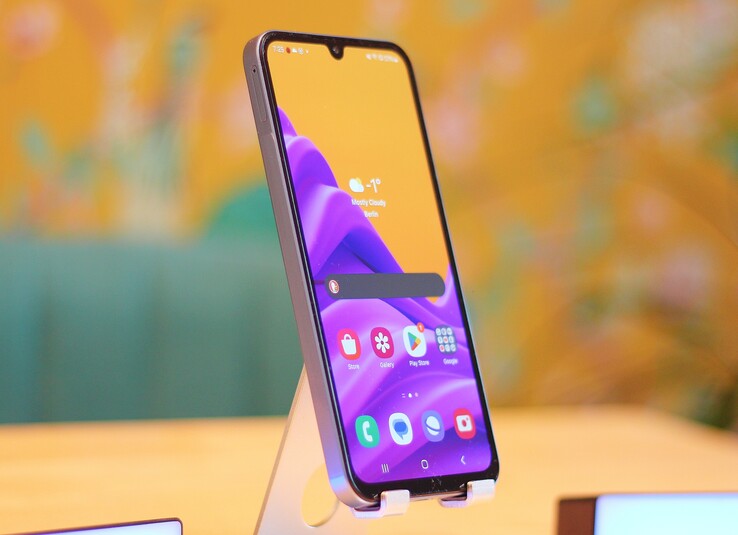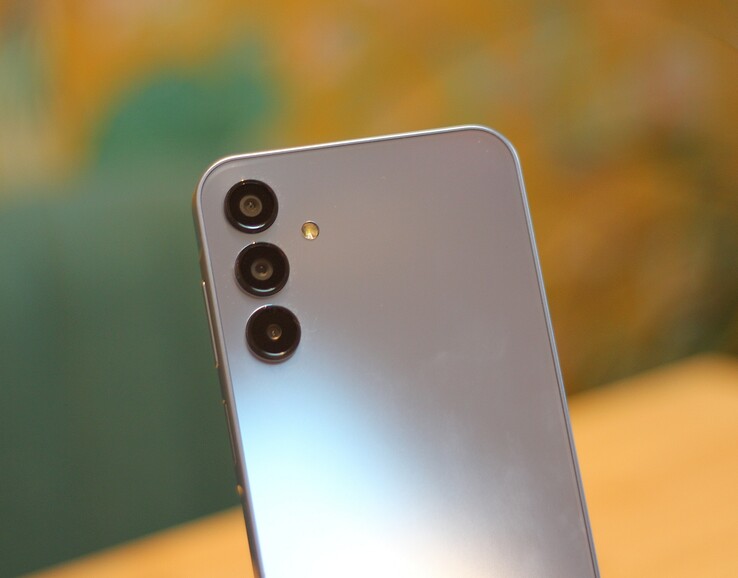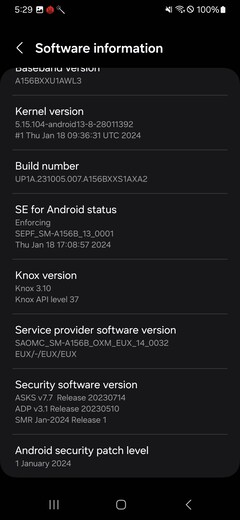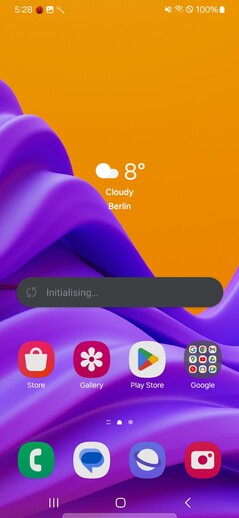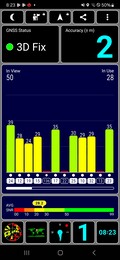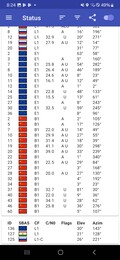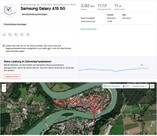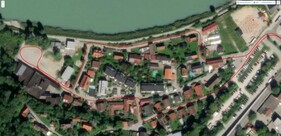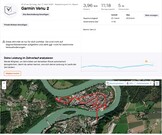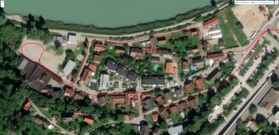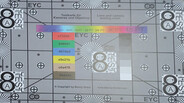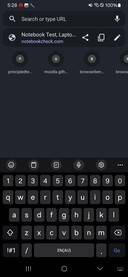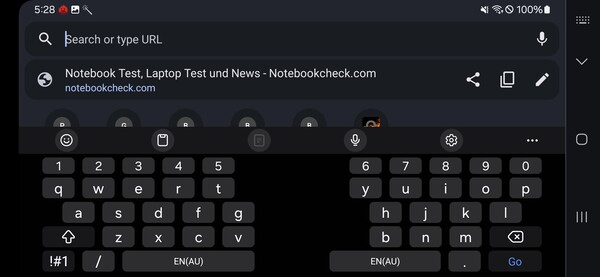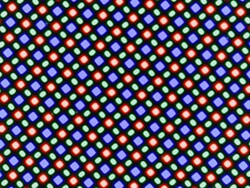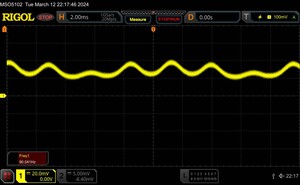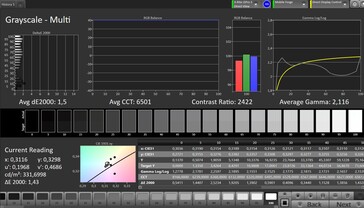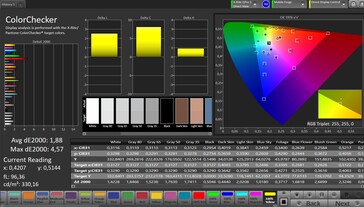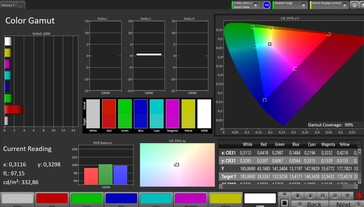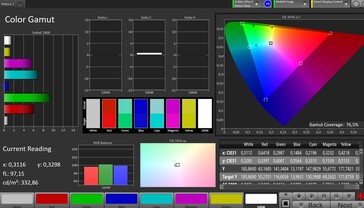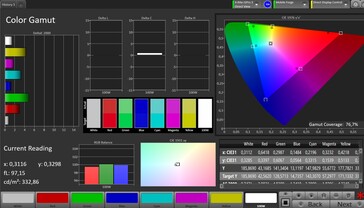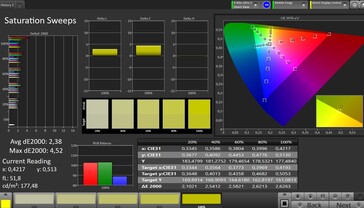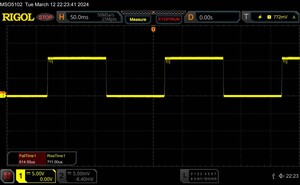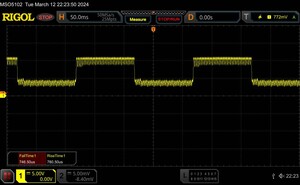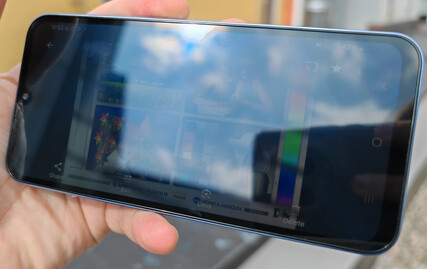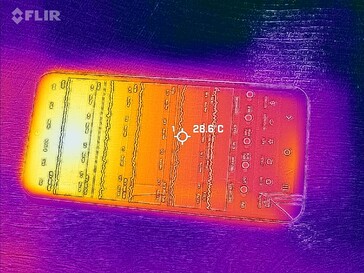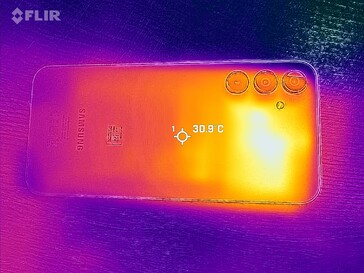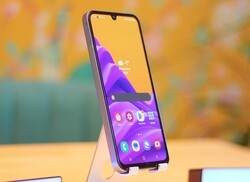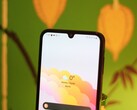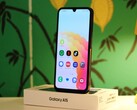Samsung Galaxy A15 5G smartphone review – Important updates for the affordable phone
One of the most inexpensive phone models from Samsung is the Galaxy A15 5G. You can currently get it from the manufacturer for around US$200. Despite its relatively low price, the smartphone features a 5G modem, so you can even make use of the most modern cellular standard.
Its predecessor, the Galaxy A14 5G, was already an interesting smartphone a year ago, however, its successor boasts quite a few new features: It is now equipped with an AMOLED screen and for the first time, has an ultra-wide-angle camera installed.
An upgrade was important, as the competition (such as from Motorola or Xiaomi) never sleeps and has now brought some very impressive models onto the market. So now we will be answering the question: Is the Samsung Galaxy A15 5G competitive again with its new features? Let's go.
Possible competitors compared
Rating | Date | Model | Weight | Drive | Size | Resolution | Price |
|---|---|---|---|---|---|---|---|
| 80.1 % v7 (old) | 03 / 2024 | Samsung Galaxy A15 5G Dimensity 6100+, Mali-G57 MP2 | 200 g | 128 GB UFS 2.2 Flash | 6.50" | 2340x1080 | |
| 79.4 % v7 (old) | 05 / 2023 | Samsung Galaxy A14 5G Dimensity 700, Mali-G57 MP2 | 202 g | 64 GB UFS 2.2 Flash | 6.60" | 2408x1080 | |
| 81.9 % v7 (old) | 03 / 2024 | Motorola Moto G34 SD 695 5G, Adreno 619 | 179 g | 128 GB UFS 2.1 Flash | 6.50" | 1600x720 | |
| 78.3 % v7 (old) | 08 / 2023 | Nokia G42 SD 480+, Adreno 619 | 194 g | 128 GB UFS 2.2 Flash | 6.56" | 1612x720 | |
| 81.7 % v7 (old) | 06 / 2023 | Xiaomi Redmi Note 12 5G SD 4 Gen 1, Adreno 619 | 189 g | 128 GB UFS 2.2 Flash | 6.67" | 2400x1080 |
Case – Plastic in fresh colors
First, we will be taking a look at its case: Compared to the Galaxy A14 5G, the phone has gotten slightly more compact; its screen now has an aspect ratio of 19.5:9. The bezels around the screen continue to be clearly visible but for a phone around the US$200 mark, this is fine.
Samsung offers various color variants for the back of its device, namely dark blue, light blue and yellow, whereby the matte back always shimmers in the light. Fingerprint marks and dust become clearly visible after a short amount of time, so you will need to clean it regularly or reach for a case. The frame is made from plastic, too but even so, the phone has been built stably and withstands pressure well. The case hardly gives way when twisted, but the phone does creak from time to time.
The material transitions are clean and the edges are well rounded. All three camera lenses are separate and are located one below the other on the left-hand side of the back. They protrude clearly from the case, so the phone tilts slightly when it is placed on the table and the touchscreen is used.
Connectivity – Good storage capacity, but no eSIM
For US$200, the Galaxy A15 5G comes with 128 GB storage and 4 GB RAM. In contrast to our test sample's predecessor, this puts Samsung back at the class level.
The USB-C port is only connected internally at USB 2.0 speed, meaning it can only transfer data at standard speed. Those who love using their headphones with an analogue jack connection will be happy about the 3.5 mm audio port.
NFC for mobile payment services is also on board. However, there is no support for eSIM, as is the case with the Motorola Moto G34, for example.
microSD card reader
In total, two SIM slots are available, one of which, however, is occupied by an inserted microSD card to expand the phone's storage. This means you'll have to decide: Either you use two SIM cards or you use one plus a microSD card.
According to our tests using the Angelbird V60 reference card, the card reader works quite quickly and during the copying test, it left most of the comparison devices from the price class in the dust.
| SD Card Reader - average JPG Copy Test (av. of 3 runs) | |
| Samsung Galaxy A14 5G (Angelbird AV Pro V60) | |
| Samsung Galaxy A15 5G (Angelbird V60) | |
| Motorola Moto G34 (Angelbird V60) | |
| Xiaomi Redmi Note 12 5G (Angelbird AV Pro V60) | |
| Nokia G42 (Angelbird V60) | |
Cross Platform Disk Test (CPDT)
Software – Long update promise with restrictions?
Android 14 comes pre-installed onto the smartphone, over which Samsung has laid its own OneUI 6.0 interface. This does change stock Android quite a bit and in some cases, it may take some getting used to if you're coming from using other manufacturers. At the same time, it comes with lots of additional useful functions, such as customizable language settings for every app, shortcuts for its standby button and simultaneous use of multiple accounts in messenger apps.
Samsung promises long updates for its phone: 4 operating system generations, so up to Android 18 and 5 years of security patches rolled out every three months. It should, however, be noted that the manufacturer reserves the right to change its update guidelines at any time, cutting its promised update support short. At the same time, it is unlikely that Samsung would want to deal with such a PR scandal, likely making this more of a legal phrase—but even so, the promise cannot be completely relied upon.
At the time of testing, our test sample's latest security update was from January 2024. This means it is still within the 3-month timeframe that the manufacturer has set out. In our experience, Samsung usually sticks to this regularity for at least the first few years.
Communication and GNSS – Speedy WLAN and international 5G
The Galaxy A15 5G supports WiFi 5 as its fastest WLAN standard and in doing so, it achieves the usual speeds around 300 - 350 MBit/s. This means you can't take advantage of a Gigabit internet connection but these differences will only make themselves known during large downloads in particular.
Close to the router, you have access to its full reception but even so, websites take quite a while to load. With a 10-metre distance to the router and with three walls in between, you only have access to half of the signal quality, so pages take even longer to load—especially ones with a lot of images.
As the Galaxy A15 5G's name already suggests, you can make use of the most up-to-date cellular standard, namely 5G. This makes this smartphone one of the cheapest that supports this feature. It covers quite a few LTE and 5G frequencies, so you can use the phone internationally. Before travelling long distances, you should be sure to check which frequencies are supported, as the Galaxy phone can't be used across the entire globe.
| Networking | |
| Samsung Galaxy A15 5G | |
| iperf3 receive AXE11000 | |
| iperf3 transmit AXE11000 | |
| Samsung Galaxy A14 5G | |
| iperf3 receive AXE11000 | |
| iperf3 transmit AXE11000 | |
| Motorola Moto G34 | |
| iperf3 receive AXE11000 | |
| iperf3 transmit AXE11000 | |
| Nokia G42 | |
| iperf3 receive AXE11000 | |
| iperf3 transmit AXE11000 | |
| Xiaomi Redmi Note 12 5G | |
| iperf3 receive AXE11000 | |
| iperf3 transmit AXE11000 | |
| Average of class Smartphone | |
| iperf3 receive AXE11000 | |
| iperf3 transmit AXE11000 | |
All major satellite networks are utilized for the phone's location services. As SBAS is also used for even more precise locating, our position was quickly determined within 2 metres outside.
We want to know just how good its locating is in everyday use and to do so, we hopped onto our bikes. Coming with us is the Garmin Venu 2 smartwatch which is well-known for its particularly accurate locating capabilities.
The Galaxy A15 5G didn't do too badly at all: Every now and then, the route recorded by the smartphone was sometimes a little off-course compared to the one we actually took, so it sometimes appeared as if we rode directly through front gardens or houses. But all-in-all, this was only noticeable if you took a really close look and generally, our route was followed well.
You can with good conscience use the phone for navigation purposes. However, if you require extreme accuracy, there are even better devices on the market.
Telephone features and call quality – Clear conversations
Samsung uses its own telephone app which places its keypad more into the foreground than the app from Google which is set as standard on Android devices. The Samsung app can be operated easily, too, offering lots of functions including blocking unwanted calls.
For desired calls, the speech quality is good for the price range. Of course, there are phones on the market where the other party sounds even clearer and more present, but our test call was easy to understand for both parties and its maximum volume is also sufficient to drown out background noise.
Via the loudspeaker and hands-free microphone, calls work just as well—owners of the Galaxy A15 5G just need to make sure to not speak too quietly, otherwise the microphone won't pick up your voice.
Cameras – Finally with a wide-angle view
Within a price range of around US$200, an ultra-wide angle lens doesn't yet come as standard, however, Samsung has possibly identified a great way of setting its phones apart from the competition.
So, for the first time, the Galaxy A15 5G also features a 5-megapixel lens specifically for taking wide-angle shots. Our test photo looked a little too high in contrast but as long as you don't enlarge it, it should look fine. Individual details can hardly be recognized. Furthermore, its field of view is considerably narrower than on high-end cameras: Converted to the 35-mm format, the camera only achieves 17 millimetres, while other smartphones achieve a focal length equivalent to 13 millimetres.
Its main camera has a resolution of 50 megapixels but it makes use of the usual pixel binning method, meaning it only actually takes photos at 12.5 MP but with a bigger light yield. In total, the photos appear a little too dark and only show an average level of detail. The dramatic sky in the landscape image was reproduced with quite a lot of detail, but other areas of the image appear somewhat washed out.
In poor lighting conditions with high contrasts, the camera may have been able to lighten the image well but in turn, a lot of smaller details were lost, especially around the candle. Moreover, the photos look very grainy and don't show a lot of detail.
The third lens on the back is a macro lens which can be used for extreme close-up shots. It takes decent photos in good lighting conditions, however, its resolution is very low, so you shouldn't try to enlarge the photos.
A 13-megapixel camera on the front stands by for all your selfie needs. The resulting photos are sharp in good lighting conditions and they can be enlarged, but darker areas only show few details.
Image comparison
Choose a scene and navigate within the first image. One click changes the position on touchscreens. One click on the zoomed-in image opens the original in a new window. The first image shows the scaled photograph of the test device.
Main camera plantMain camera landscapeMain camera low lightWide-angle cameraIn our lab with full studio lighting, the main camera only showed little sharpness when it came to detail and contrast. At only 1 lux lighting, rough details were still recognizable.
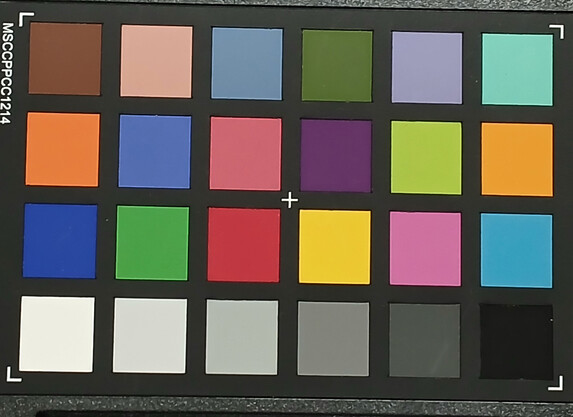
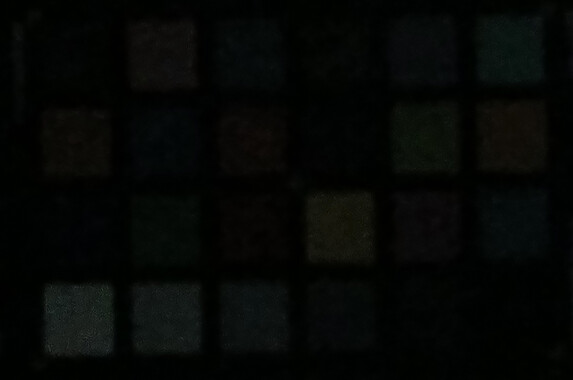
Accessories and warranty – No charger included
Samsung doesn't deliver the phone with a charger. The manufacturer sells the corresponding 25-watt charger via its Amazon store for around US$10. The box only includes a USB cable and a SIM tool.
The manufacturer has given this phone a standard 12-month warranty in the United States. There are many Samsung service centres in larger cities that you can take devices to to be repaired.
Input devices & operation – Reliable fingerprint sensor
Samsung has installed its own keyboard app onto the smartphone with which you can type reliably. If you would rather use a different display keyboard, then you can easily download lots of different ones from the Google Play Store.
Its touchscreen is scanned for touches up to 90 times per second and can be operated reactively and reliably. The touchscreen also works perfectly right into the corners and along the edges.
A fingerprint sensor is integrated into the standby button on the right-hand side of the case. It unlocks the device after a very short waiting time, usually on the first attempt.
You can also use facial recognition to unlock the device. This is a 2D method using the front-facing camera, so it isn't quite as protected against manipulation. Nevertheless, it works quickly and reliably.
Display – Bright OLED as a highlight
Its slightly enhanced Full-HD resolution and 6.5-inch screen make the phone class-level for the first time ever, whereby some of the competition does still offer lower-res screens. On the other hand, an AMOLED screen is quite rare within this price class and this is another new feature the Galaxy A15 5G boasts. Its refresh rate remains unchanged at 90 Hz.
The screen's maximum brightness is around 700 cd/m², making it good to use even in bright surroundings. Furthermore, its contrast is technically infinitely high thanks to its AMOLED technology, which lets colors glow.
We noted that the display flickers at low brightness levels, however, this is adapted to the refresh rate—plus, the brightness fluctuations are quite small. Sensitive people should still try out the screen before buying, as problems such as headaches cannot be ruled out with prolonged use.
| |||||||||||||||||||||||||
Brightness Distribution: 96 %
Center on Battery: 705 cd/m²
Contrast: ∞:1 (Black: 0 cd/m²)
ΔE ColorChecker Calman: 1.88 | ∀{0.5-29.43 Ø4.77}
ΔE Greyscale Calman: 1.5 | ∀{0.09-98 Ø5}
99% sRGB (Calman 2D)
Gamma: 2.116
CCT: 6501 K
| Samsung Galaxy A15 5G AMOLED, 2340x1080, 6.5" | Samsung Galaxy A14 5G PLS LCD, 2408x1080, 6.6" | Motorola Moto G34 IPS, 1600x720, 6.5" | Nokia G42 IPS, 1612x720, 6.6" | Xiaomi Redmi Note 12 5G AMOLED, 2400x1080, 6.7" | |
|---|---|---|---|---|---|
| Screen | -169% | -27% | -116% | 7% | |
| Brightness middle (cd/m²) | 705 | 579 -18% | 523 -26% | 495 -30% | 658 -7% |
| Brightness (cd/m²) | 701 | 543 -23% | 512 -27% | 452 -36% | 663 -5% |
| Brightness Distribution (%) | 96 | 87 -9% | 95 -1% | 84 -12% | 98 2% |
| Black Level * (cd/m²) | 0.57 | 0.47 | 0.5 | ||
| Colorchecker dE 2000 * | 1.88 | 7.6 -304% | 1.89 -1% | 6.09 -224% | 1.4 26% |
| Colorchecker dE 2000 max. * | 4.57 | 12.7 -178% | 4.63 -1% | 9.35 -105% | 2.7 41% |
| Greyscale dE 2000 * | 1.5 | 8.7 -480% | 3.1 -107% | 5.8 -287% | 1.7 -13% |
| Gamma | 2.116 104% | 2.23 99% | 2.262 97% | 2.325 95% | 2.23 99% |
| CCT | 6501 100% | 9344 70% | 6471 100% | 8169 80% | 6504 100% |
| Contrast (:1) | 1016 | 1113 | 990 |
* ... smaller is better
Screen Flickering / PWM (Pulse-Width Modulation)
| Screen flickering / PWM detected | 90 Hz | ||
The display backlight flickers at 90 Hz (worst case, e.g., utilizing PWM) . The frequency of 90 Hz is very low, so the flickering may cause eyestrain and headaches after extended use. In comparison: 53 % of all tested devices do not use PWM to dim the display. If PWM was detected, an average of 8084 (minimum: 5 - maximum: 343500) Hz was measured. | |||
Measurement series with fixed zoom level and different brightness settings
Using the color mode "Natural", which can be found in the phone's screen settings, we achieved a very accurate display of colors and grayscale in our tests using a spectrophotometer and CalMAN software. This means that the screen can also be used for professional purposes.
Display Response Times
| ↔ Response Time Black to White | ||
|---|---|---|
| 1.3 ms ... rise ↗ and fall ↘ combined | ↗ 0.6 ms rise | |
| ↘ 0.7 ms fall | ||
| The screen shows very fast response rates in our tests and should be very well suited for fast-paced gaming. In comparison, all tested devices range from 0.1 (minimum) to 240 (maximum) ms. » 6 % of all devices are better. This means that the measured response time is better than the average of all tested devices (20.2 ms). | ||
| ↔ Response Time 50% Grey to 80% Grey | ||
| 1.6 ms ... rise ↗ and fall ↘ combined | ↗ 0.8 ms rise | |
| ↘ 0.8 ms fall | ||
| The screen shows very fast response rates in our tests and should be very well suited for fast-paced gaming. In comparison, all tested devices range from 0.165 (minimum) to 636 (maximum) ms. » 7 % of all devices are better. This means that the measured response time is better than the average of all tested devices (31.6 ms). | ||
Outside and with the phone's brightness sensor activated, the display usually manages to display content in a way that you can still recognize it despite the sky being reflected. Still, it is a lot more comfortable to work in darker locations.
Its viewing angles are unobjectionable, so the display is also easy to read from the side.
Performance – More power would be good
Although the Samsung Galaxy A15 5G features a new SoC compared to last year's Galaxy A14 5G, it can't really be classed as a step forward, as it only offers minimal improvements. The MediaTek Dimensity 6100+ works with exactly the same cores and clock rate as the SoC in the predecessor model—it is just manufactured using the slightly more efficient 6 nm process.
Unfortunately, the SoC's performance isn't very impressive—even for this relatively inexpensive price class. In the vast majority of benchmarks, the Galaxy A15 5G only managed to occupy the last few places and every now and then, it achieved average results within the comparison field. These days, you can find much more powerful smartphones for a similar price, and you notice this during everyday use, too: You will often find yourself waiting for things to load and dealing with dropped frames when using the phone.
| UL Procyon AI Inference for Android - Overall Score NNAPI | |
| Average of class Smartphone (3769 - 81594, n=132, last 2 years) | |
| Average MediaTek Dimensity 6100+ (6283 - 6895, n=3) | |
| Samsung Galaxy A14 5G | |
| Samsung Galaxy A15 5G | |
| Motorola Moto G34 | |
| Xiaomi Redmi Note 12 5G | |
| Nokia G42 | |
The SoC doesn't impress in terms of its graphics performance, either: Most of the comparison devices were able to deliver more power. So, if you enjoy playing games or would like to use more demanding apps, then you should probably look elsewhere.
GFXBench (DX / GLBenchmark) 2.7: T-Rex Onscreen | 1920x1080 T-Rex Offscreen
GFXBench 3.0: on screen Manhattan Onscreen OGL | 1920x1080 1080p Manhattan Offscreen
GFXBench 3.1: on screen Manhattan ES 3.1 Onscreen | 1920x1080 Manhattan ES 3.1 Offscreen
GFXBench: on screen Car Chase Onscreen | 1920x1080 Car Chase Offscreen | on screen Aztec Ruins High Tier Onscreen | 2560x1440 Aztec Ruins High Tier Offscreen | on screen Aztec Ruins Normal Tier Onscreen | 1920x1080 Aztec Ruins Normal Tier Offscreen | 3840x2160 4K Aztec Ruins High Tier Offscreen
| 3DMark / Wild Life Extreme Unlimited | |
| Motorola Moto G34 | |
| Samsung Galaxy A15 5G | |
| Samsung Galaxy A14 5G | |
| Nokia G42 | |
| Xiaomi Redmi Note 12 5G | |
| 3DMark / Wild Life Extreme | |
| Motorola Moto G34 | |
| Samsung Galaxy A15 5G | |
| Samsung Galaxy A14 5G | |
| Nokia G42 | |
| Xiaomi Redmi Note 12 5G | |
| 3DMark / Wild Life Unlimited Score | |
| Motorola Moto G34 | |
| Samsung Galaxy A15 5G | |
| Samsung Galaxy A14 5G | |
| Nokia G42 | |
| Xiaomi Redmi Note 12 5G | |
| 3DMark / Wild Life Score | |
| Samsung Galaxy A15 5G | |
| Motorola Moto G34 | |
| Samsung Galaxy A14 5G | |
| Nokia G42 | |
| Xiaomi Redmi Note 12 5G | |
| 3DMark / Sling Shot Extreme (Vulkan) Unlimited Physics | |
| Samsung Galaxy A14 5G | |
| Nokia G42 | |
| Samsung Galaxy A15 5G | |
| Xiaomi Redmi Note 12 5G | |
| 3DMark / Sling Shot Extreme (Vulkan) Unlimited Graphics | |
| Xiaomi Redmi Note 12 5G | |
| Samsung Galaxy A14 5G | |
| Samsung Galaxy A15 5G | |
| Nokia G42 | |
| 3DMark / Sling Shot Extreme (Vulkan) Unlimited | |
| Xiaomi Redmi Note 12 5G | |
| Samsung Galaxy A14 5G | |
| Samsung Galaxy A15 5G | |
| Nokia G42 | |
| 3DMark / Sling Shot Extreme (ES 3.1) Unlimited Physics | |
| Samsung Galaxy A14 5G | |
| Nokia G42 | |
| Samsung Galaxy A15 5G | |
| Xiaomi Redmi Note 12 5G | |
| 3DMark / Sling Shot Extreme (ES 3.1) Unlimited Graphics | |
| Xiaomi Redmi Note 12 5G | |
| Nokia G42 | |
| Samsung Galaxy A14 5G | |
| Samsung Galaxy A15 5G | |
| 3DMark / Sling Shot Extreme (ES 3.1) Unlimited | |
| Xiaomi Redmi Note 12 5G | |
| Nokia G42 | |
| Samsung Galaxy A14 5G | |
| Samsung Galaxy A15 5G | |
| GFXBench (DX / GLBenchmark) 2.7 / T-Rex Onscreen | |
| Motorola Moto G34 | |
| Nokia G42 | |
| Xiaomi Redmi Note 12 5G | |
| Samsung Galaxy A14 5G | |
| Samsung Galaxy A15 5G | |
| GFXBench (DX / GLBenchmark) 2.7 / T-Rex Offscreen | |
| Motorola Moto G34 | |
| Xiaomi Redmi Note 12 5G | |
| Nokia G42 | |
| Samsung Galaxy A14 5G | |
| Samsung Galaxy A15 5G | |
| GFXBench 3.0 / Manhattan Onscreen OGL | |
| Motorola Moto G34 | |
| Nokia G42 | |
| Xiaomi Redmi Note 12 5G | |
| Samsung Galaxy A15 5G | |
| Samsung Galaxy A14 5G | |
| GFXBench 3.0 / 1080p Manhattan Offscreen | |
| Motorola Moto G34 | |
| Xiaomi Redmi Note 12 5G | |
| Nokia G42 | |
| Samsung Galaxy A15 5G | |
| Samsung Galaxy A14 5G | |
| GFXBench 3.1 / Manhattan ES 3.1 Onscreen | |
| Motorola Moto G34 | |
| Nokia G42 | |
| Xiaomi Redmi Note 12 5G | |
| Samsung Galaxy A15 5G | |
| Samsung Galaxy A14 5G | |
| GFXBench 3.1 / Manhattan ES 3.1 Offscreen | |
| Motorola Moto G34 | |
| Xiaomi Redmi Note 12 5G | |
| Nokia G42 | |
| Samsung Galaxy A15 5G | |
| Samsung Galaxy A14 5G | |
| GFXBench / Car Chase Onscreen | |
| Motorola Moto G34 | |
| Nokia G42 | |
| Xiaomi Redmi Note 12 5G | |
| Samsung Galaxy A14 5G | |
| Samsung Galaxy A15 5G | |
| GFXBench / Car Chase Offscreen | |
| Motorola Moto G34 | |
| Xiaomi Redmi Note 12 5G | |
| Nokia G42 | |
| Samsung Galaxy A14 5G | |
| Samsung Galaxy A15 5G | |
| GFXBench / Aztec Ruins High Tier Onscreen | |
| Motorola Moto G34 | |
| Nokia G42 | |
| Xiaomi Redmi Note 12 5G | |
| Samsung Galaxy A15 5G | |
| Samsung Galaxy A14 5G | |
| GFXBench / Aztec Ruins High Tier Offscreen | |
| Motorola Moto G34 | |
| Xiaomi Redmi Note 12 5G | |
| Nokia G42 | |
| Samsung Galaxy A15 5G | |
| Samsung Galaxy A14 5G | |
| GFXBench / Aztec Ruins Normal Tier Onscreen | |
| Motorola Moto G34 | |
| Nokia G42 | |
| Xiaomi Redmi Note 12 5G | |
| Samsung Galaxy A15 5G | |
| Samsung Galaxy A14 5G | |
| GFXBench / Aztec Ruins Normal Tier Offscreen | |
| Motorola Moto G34 | |
| Xiaomi Redmi Note 12 5G | |
| Nokia G42 | |
| Samsung Galaxy A15 5G | |
| Samsung Galaxy A14 5G | |
| GFXBench / 4K Aztec Ruins High Tier Offscreen | |
| Motorola Moto G34 | |
| Xiaomi Redmi Note 12 5G | |
| Nokia G42 | |
| Samsung Galaxy A15 5G | |
| Samsung Galaxy A14 5G | |
When loading large websites, you'll have to make do with some waiting times now and then—especially when waiting for images to load in. During the benchmarks, our test sample may have been good enough to achieve average results, but this also has to do with its more up-to-date browser version.
| Jetstream 2 - 2.0 Total Score | |
| Average of class Smartphone (23.8 - 387, n=147, last 2 years) | |
| Motorola Moto G34 (Chrome 122) | |
| Samsung Galaxy A15 5G (Chrome 122) | |
| Average MediaTek Dimensity 6100+ (74.5 - 75, n=3) | |
| Nokia G42 (Chrome 115) | |
| Xiaomi Redmi Note 12 5G (Chrome 113.0.5672.76) | |
| Samsung Galaxy A14 5G (Chrome 112) | |
| Speedometer 2.0 - Result 2.0 | |
| Average of class Smartphone (15.2 - 643, n=119, last 2 years) | |
| Motorola Moto G34 (Chrome 122) | |
| Average MediaTek Dimensity 6100+ (56.5 - 63.3, n=3) | |
| Samsung Galaxy A15 5G (Chrome 122) | |
| Xiaomi Redmi Note 12 5G (Chrome 113.0.5672.76) | |
| Nokia G42 (Chrome 115) | |
| Samsung Galaxy A14 5G (Chrome 112) | |
| WebXPRT 4 - Overall | |
| Average of class Smartphone (27 - 306, n=143, last 2 years) | |
| Motorola Moto G34 (Chrome 122) | |
| Average MediaTek Dimensity 6100+ (75 - 79, n=3) | |
| Samsung Galaxy A15 5G (Chrome 122) | |
| Xiaomi Redmi Note 12 5G (Chrome 113.0.5672.76) | |
| Nokia G42 (Chrome 115) | |
| Samsung Galaxy A14 5G (2111) | |
| Octane V2 - Total Score | |
| Average of class Smartphone (2228 - 126661, n=194, last 2 years) | |
| Motorola Moto G34 (Chrome 122) | |
| Average MediaTek Dimensity 6100+ (21764 - 22638, n=5) | |
| Samsung Galaxy A15 5G (Chrome 122) | |
| Nokia G42 (Chrome 115) | |
| Xiaomi Redmi Note 12 5G (Chrome 113.0.5672.76) | |
| Samsung Galaxy A14 5G (Chrome 112) | |
| Mozilla Kraken 1.1 - Total | |
| Samsung Galaxy A14 5G (Chrome 112) | |
| Nokia G42 (Chrome 115) | |
| Xiaomi Redmi Note 12 5G (Chrome 113.0.5672.76) | |
| Samsung Galaxy A15 5G (Chrome 122) | |
| Average MediaTek Dimensity 6100+ (1984 - 2003, n=3) | |
| Motorola Moto G34 (Chrome 122) | |
| Average of class Smartphone (257 - 28190, n=154, last 2 years) | |
* ... smaller is better
Its storage actually even seems to be worse off than that of the Samsung Galaxy A14 5G: The storage controller proved to be much slower and this became especially apparent during the sequential reading test.
Even so, compared to other smartphones within this price class, the Galaxy A15 5G is at least on par when it comes to its storage speed.
| Samsung Galaxy A15 5G | Samsung Galaxy A14 5G | Motorola Moto G34 | Nokia G42 | Xiaomi Redmi Note 12 5G | Average 128 GB UFS 2.2 Flash | Average of class Smartphone | |
|---|---|---|---|---|---|---|---|
| AndroBench 3-5 | 14% | -4% | -11% | -9% | 10% | 182% | |
| Sequential Read 256KB (MB/s) | 499.6 | 849.3 70% | 524.1 5% | 492.5 -1% | 520.09 4% | 739 ? 48% | 2235 ? 347% |
| Sequential Write 256KB (MB/s) | 498.1 | 469.83 -6% | 495 -1% | 461.8 -7% | 505.55 1% | 536 ? 8% | 1871 ? 276% |
| Random Read 4KB (MB/s) | 194 | 193.63 0% | 192.1 -1% | 183.3 -6% | 170.61 -12% | 193.6 ? 0% | 297 ? 53% |
| Random Write 4KB (MB/s) | 223.5 | 204 -9% | 180.2 -19% | 161.1 -28% | 161.26 -28% | 186.7 ? -16% | 343 ? 53% |
| Samsung Galaxy A15 5G | Motorola Moto G34 | Average 128 GB UFS 2.2 Flash | Average of class Smartphone | |
|---|---|---|---|---|
| PCMark for Android | 16% | 25% | 212% | |
| Storage 2.0 seq. read int. (MB/s) | 449 ? | 462 ? 3% | 602 ? 34% | 1704 ? 280% |
| Storage 2.0 seq. write int. (MB/s) | 372 ? | 420 ? 13% | 451 ? 21% | 1576 ? 324% |
| Storage 2.0 random read int. (MB/s) | 27.7 ? | 29 ? 5% | 29.3 ? 6% | 42.9 ? 55% |
| Storage 2.0 random write int. (MB/s) | 29 ? | 41.9 ? 44% | 44.5 ? 53% | 69.7 ? 140% |
| Storage 2.0 (Points) | 16516 ? | 18862 ? 14% | 18742 ? 13% | 59738 ? 262% |
Games – More basic gaming
Gaming is fun on the Samsung Galaxy A15 5G as long as you don't set your expectations all too high: The phone can display games like Genshin Impact or PUBG Mobile at 30fps with high details, however, the frame rates aren't reliable and we noted frequent drops.
If you set the details to low, then you can actually expect up to 40fps—but its stability still isn't great. We measured our frame rates using the software from GameBench.
All-in-all, the Samsung phone is more suitable for gamers who are happy with casual gaming or who don't mind the odd dropped frame when playing something more demanding.
During our test, controlling games via the touchscreen and (if applicable) the position sensor worked flawlessly.
Emissions – The Galaxy A15 5G gets quite warm
Temperature
After being under load for a longer period of time, we noted up to 45.5 °C on the surface of the phone. This is clearly noticeable and it might get a little uncomfortable—not to mention the fact we took these measurements at room temperature. Higher ambient temperatures could lead the temperatures to rise even further.
On a positive note, the phone's high temperatures don't impact the SoC's performance: Even after 20 runs of one benchmark, the frame rates remained stable.
(±) The maximum temperature on the upper side is 43.4 °C / 110 F, compared to the average of 35.2 °C / 95 F, ranging from 21.9 to 247 °C for the class Smartphone.
(-) The bottom heats up to a maximum of 45.5 °C / 114 F, compared to the average of 34 °C / 93 F
(+) In idle usage, the average temperature for the upper side is 23.3 °C / 74 F, compared to the device average of 32.9 °C / 91 F.
3DMark Wild Life Stress Test
| 3DMark | |
| Wild Life Stress Test Stability | |
| Samsung Galaxy A14 5G | |
| Nokia G42 | |
| Motorola Moto G34 | |
| Samsung Galaxy A15 5G | |
| Wild Life Extreme Stress Test | |
| Nokia G42 | |
| Motorola Moto G34 | |
| Samsung Galaxy A14 5G | |
| Samsung Galaxy A15 5G | |
Speaker
The speaker on the bottom edge delivers good mono sound even at high volumes. You shouldn't expect low mids or bass and its sound is a little treble-heavy. As a result, voices and vocals are quite easy to understand, but music has little fullness overall and movie effects sound a little weak.
You can get more oomph by connecting external speakers or headphones. This works via the analogue 3.5mm audio jack as well as via Bluetooth. With Samsung, you shouldn't expect too much choice when it comes to wireless audio codecs: In addition to the in-house SSC, which is mainly supported by Samsung headphones, there is SBC, aptX, LDAC and AAC available.
Samsung Galaxy A15 5G audio analysis
(+) | speakers can play relatively loud (83.7 dB)
Bass 100 - 315 Hz
(-) | nearly no bass - on average 27.8% lower than median
(±) | linearity of bass is average (11% delta to prev. frequency)
Mids 400 - 2000 Hz
(±) | higher mids - on average 5.7% higher than median
(±) | linearity of mids is average (7% delta to prev. frequency)
Highs 2 - 16 kHz
(±) | higher highs - on average 5.2% higher than median
(±) | linearity of highs is average (8.2% delta to prev. frequency)
Overall 100 - 16.000 Hz
(±) | linearity of overall sound is average (22.3% difference to median)
Compared to same class
» 47% of all tested devices in this class were better, 7% similar, 46% worse
» The best had a delta of 11%, average was 35%, worst was 134%
Compared to all devices tested
» 64% of all tested devices were better, 6% similar, 30% worse
» The best had a delta of 4%, average was 24%, worst was 134%
Xiaomi Redmi Note 12 5G audio analysis
(+) | speakers can play relatively loud (91.5 dB)
Bass 100 - 315 Hz
(-) | nearly no bass - on average 30.6% lower than median
(+) | bass is linear (4.2% delta to prev. frequency)
Mids 400 - 2000 Hz
(±) | reduced mids - on average 5.9% lower than median
(+) | mids are linear (5.2% delta to prev. frequency)
Highs 2 - 16 kHz
(+) | balanced highs - only 3.7% away from median
(+) | highs are linear (3% delta to prev. frequency)
Overall 100 - 16.000 Hz
(±) | linearity of overall sound is average (18.9% difference to median)
Compared to same class
» 23% of all tested devices in this class were better, 10% similar, 67% worse
» The best had a delta of 11%, average was 35%, worst was 134%
Compared to all devices tested
» 43% of all tested devices were better, 8% similar, 49% worse
» The best had a delta of 4%, average was 24%, worst was 134%
Battery life – Speedy charging and good runtimes
Power consumption
The phone's power consumption is relatively low, so the SoC's efficiency improvements seem to work well compared to its predecessor.
The smartphone can be charged at up to 25 watts. A charger is not included in the package, but the smartphone worked without any problems using all the different branded chargers we tested. Its increased charging power compared to its predecessor also reduces how long the device takes to charge: it takes a maximum of 2 hours to fully charge the 5,000 mAh battery.
| Off / Standby | |
| Idle | |
| Load |
|
Key:
min: | |
| Samsung Galaxy A15 5G 5000 mAh | Samsung Galaxy A14 5G 5000 mAh | Motorola Moto G34 5000 mAh | Xiaomi Redmi Note 12 5G 5000 mAh | Average MediaTek Dimensity 6100+ | Average of class Smartphone | |
|---|---|---|---|---|---|---|
| Power Consumption | -25% | -10% | -21% | 5% | -61% | |
| Idle Minimum * (Watt) | 1.1 | 0.64 42% | 1 9% | 0.99 10% | 1.05 ? 5% | 0.847 ? 23% |
| Idle Average * (Watt) | 1.3 | 2.1 -62% | 1.5 -15% | 1.98 -52% | 1.25 ? 4% | 1.448 ? -11% |
| Idle Maximum * (Watt) | 1.5 | 2.17 -45% | 1.8 -20% | 2.02 -35% | 1.4 ? 7% | 1.633 ? -9% |
| Load Average * (Watt) | 2.6 | 3.73 -43% | 3.2 -23% | 3.35 -29% | 2.45 ? 6% | 6.96 ? -168% |
| Load Maximum * (Watt) | 4.7 | 5.44 -16% | 4.8 -2% | 4.72 -0% | 4.6 ? 2% | 11.3 ? -140% |
* ... smaller is better
Power consumption: Geekbench (150 cd/m²)
Power consumption: GFXBench (150 cd/m²)
Runtimes
In terms of runtimes, the Galaxy A15 5G proves to be quite competitive within its price range—but it fell slightly short compared to its direct predecessor. The phone lasted significantly shorter, especially when measuring its idle runtimes, i.e. without a high load.
However, lasting for over 16 hours in our WLAN test, it should still be enough for a rainy day on your phone without needing to charge. Almost 19:18 hours of video playback from the internal storage is just not enough to watch all 8 Harry Potter movies in one go.
The phone lasted for 5:38 hours under load, so you can easily play games for that long.
| Samsung Galaxy A15 5G 5000 mAh | Samsung Galaxy A14 5G 5000 mAh | Motorola Moto G34 5000 mAh | Nokia G42 5000 mAh | Xiaomi Redmi Note 12 5G 5000 mAh | |
|---|---|---|---|---|---|
| Battery runtime | 13% | -3% | -3% | -8% | |
| Reader / Idle (h) | 29.3 | 42.6 45% | 24.5 -16% | 27.8 -5% | |
| H.264 (h) | 19.3 | 18.5 -4% | 20.1 4% | 17.8 -8% | |
| WiFi v1.3 (h) | 16.1 | 17.2 7% | 16.6 3% | 15.6 -3% | 10.8 -33% |
| Load (h) | 5.6 | 5.7 2% | 5.5 -2% | 6.5 16% |
Pros
Cons
Verdict – Recommended thanks to its improvements
It's quite affordable, still supports 5G and new features include a Full HD AMOLED screen, an ultra-wide-angle camera, faster charging and 5 years of security updates—the Samsung Galaxy A15 5G has been given some important updates which, on the one hand, keep it from trailing behind the competition. But on the other hand, the manufacturer has made it clear that you can still get a good variety of features for little money.
A few smaller compromises spoil the fun surrounding the inexpensive mid-range phone's good features ever so slightly: Samsung has made its update promise a little shaky by adding the phrasing "up to", you don't get a charger with the phone and its ultra-wide-angle lens offers a much worse field of view than other phones.
If you want to use your phone without a protective case, then you'll have to get used to fingerprint marks on the back and you'll first have to spend some time uninstalling pre-installed software if you seek a pure system. Samsung could've done with giving its affordable phone even more power, too, as you will sometimes have to make do with the occasional dropped frame and waiting times.
Even so, there is a lot about the Galaxy A15 5G that we like: Its relatively precise location services, reliable WLAN, good runtimes and bright display, just to name a few. In total, this makes the Samsung phone into a very high-quality choice.
Samsung's Galaxy A15 5G is a worthy affordable mid-range phone that, compared to its predecessor, brings improvements in all the right areas.
If you don't place much importance on an AMOLED screen, then you can get the phone's predecessor for little money, namely the Galaxy A14 5G. Another viable alternative is the Motorola Moto G34 5G, although you will have to make do with a lower-res screen.
Price and availability
Currently, you can get the Galaxy A15 5G from Amazon for US$199.99.
Samsung Galaxy A15 5G
- 03/27/2024 v7 (old)
Florian Schmitt
Transparency
The selection of devices to be reviewed is made by our editorial team. The test sample was provided to the author as a loan by the manufacturer or retailer for the purpose of this review. The lender had no influence on this review, nor did the manufacturer receive a copy of this review before publication. There was no obligation to publish this review. As an independent media company, Notebookcheck is not subjected to the authority of manufacturers, retailers or publishers.
This is how Notebookcheck is testing
Every year, Notebookcheck independently reviews hundreds of laptops and smartphones using standardized procedures to ensure that all results are comparable. We have continuously developed our test methods for around 20 years and set industry standards in the process. In our test labs, high-quality measuring equipment is utilized by experienced technicians and editors. These tests involve a multi-stage validation process. Our complex rating system is based on hundreds of well-founded measurements and benchmarks, which maintains objectivity. Further information on our test methods can be found here.




